With fewer boats in the contest and the lack of a full roster of categories, they may not have broken into the winner’s circle for 2021, but every nominee—from an all-electric ocean-crosser from Sweden to a versatile variable-keel design from the United Kingdom—gave the judges plenty to consider and sparked some lively deliberations. Here are the year’s other contenders for Boat of the Year.
Arcona 435
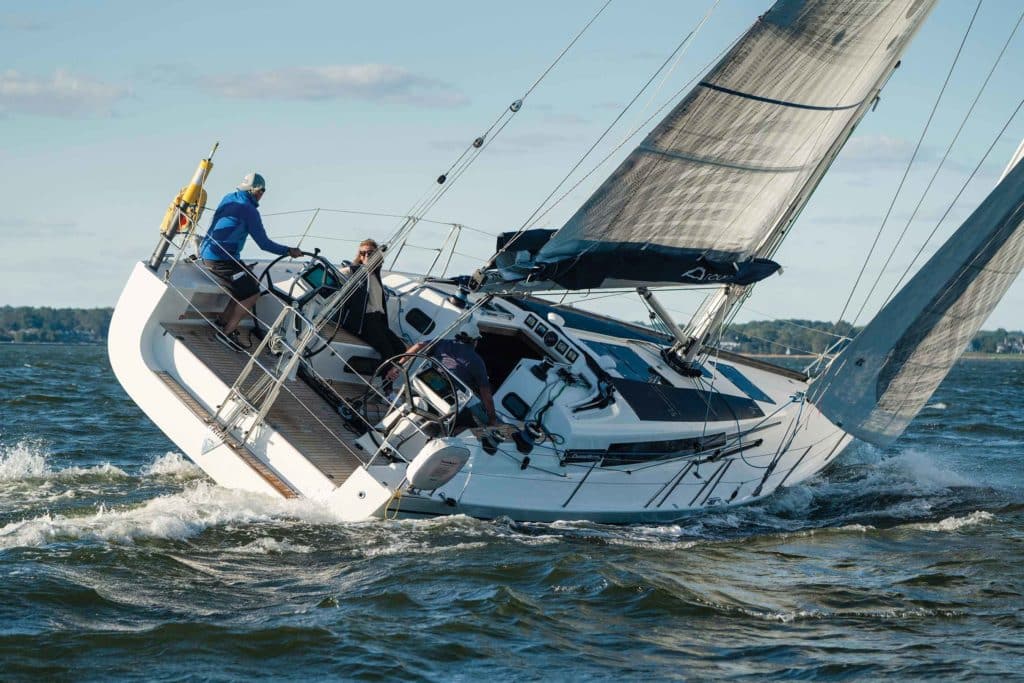
Sailing the Body Electric
Even though Swedish builder Arcona has been in business since 1971, for our entire judging panel, it was our first experience aboard one of these peppy performance cruisers, and it was memorable for being the windiest, most eventful sail in our 2021 trials. With the winds gusting into the high teens and low 20s, we tore across Chesapeake Bay aboard the Arcona 435 with a set of hands on the helm and another on the mainsheet and traveler. Good times!
The US importer for the Arcona is Graham Balch from Green Marine in San Francisco, and his greeting to us was certainly unique: “Welcome to the electric revolution on the water!”
Judge Tim Murphy explains: “This boat is arguably the most innovative boat that was brought to our contest this year. The greatest innovation, however, is not the boat itself, but in the power plant: the electrical and propulsion systems.
“To my knowledge, this is the first-ever entry in Boat of the Year that’s an all-electric system, not a hybrid. There’s no fossil-fuel engine on this boat. The guts of it is an Oceanvolt servo-prop system in conjunction with a lithium-ion battery pack. It includes a saildrive unit, the proper name for which is a synchronous permanent magnet electric motor. It’s unlike anything we’ve tested before.”
In his work with the ABYC, Murphy is familiar with the new standards—the first ever—for lithium-ion batteries. And a good thing for judge Mark Pillsbury and me, for his overall take on them was educational:
“Within sailing,” he patiently explained, “there are choices about innovation in technology versus stable technology. So, there’s known technology where there’s a long database of maintenance and service and those kinds of things. With newer technologies, like this one, the owner then is going to take on more risk in terms of the maintenance cycles and those kinds of things. I think this Oceanvolt system is a huge leap in that direction. This power plant is based entirely on those lithium-ion batteries. The benefit of lithium-ion is that it gives a greater power density for the weight of the batteries. An owner would need a lot of comfort and a lot of understanding with that battery-management system, which presents its own set of challenges. And the success rises or falls on the operator’s understanding and knowledge of all that.”
Finally, Murphy said: “In its most basic terms, the propulsion plant that drives all this—the Oceanvolt servo-prop—works on the concept of regeneration. When you’re sailing, you can put that servo prop in a mode where it’s spinning. So, the boat’s speed spins the prop, which puts juice back into the battery bank.”
Testing the Arcona, obviously, was a unique experience. And Murphy will revisit this entire matter in an article on the Oceanvolt technology in an upcoming issue of CW.
2021 Boat of the Year Winners at a Glance
Beneteau Oceanis 40.1
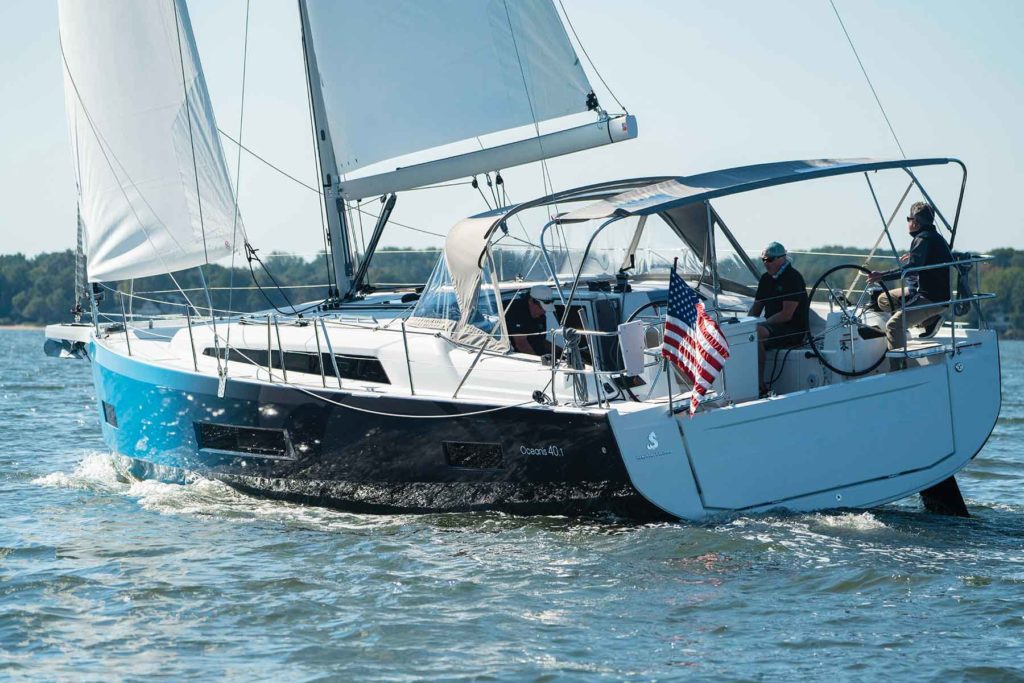
Most for the Coast
The Beneteau Oceanis 40.1 replaces the company’s previous 41-footer in the brand’s lineup, a very successful model that was introduced in 2014 and sold 550 units. All indications suggest that this striking, highly versatile 42-foot Marc Lombard-designed sloop will attract solid numbers of owners as well. A Beneteau representative said that early sales have attracted sailors with hopes of trans-Atlantic crossings and even offshore races, but we felt the sweet spot for the boat was coastal cruising for a couple and even living aboard. Pillsbury praised the two-cabin, single-head configuration of our test boat as just right, and underscored that with high marks for the so-named C-shaped galley that provides the onboard chef with plenty of space to work and create.
Yet another trend that continued among the monohull fleet for 2021 was carrying the beam well aft, and using that extra room not only for volume below, but for a vast cockpit that, at anchor—coupled with a fine drop-down swim platform—basically serves as a big patio (complete with a handy saltwater swimming pool), greatly expanding the usable open-air living and recreational space on the boat. A pair of twin rudders (trend alert!) makes that generous beam possible under sail.
Several different “packages” are available, with varying levels of comfort and performance options. Our trial model was set up to optimize performing under sail, and she certainly did. The dual helms were light, and the boat tracked like a freight train. A Code Zero headsail was a delightful addition when sheeted home on a close reach. Smart features like a cockpit table with a dedicated spot to stash a life raft were quite clever. We expect to see plenty of Oceanis 40.1′s being enjoyed near and far in the seasons ahead.
Dufour 530
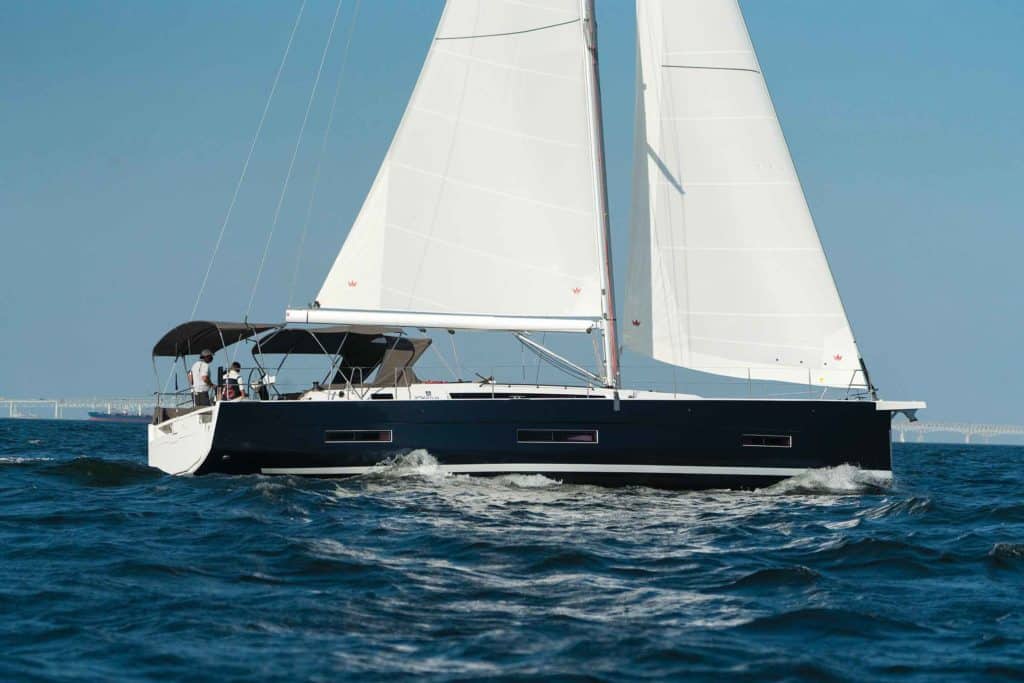
Consistently Consistent
For 2021, we’ve spoken at length about trends and innovations in the marketplace, but when we start discussing Dufour—which, with its new 530, gives the renowned French builder nine models currently in production—what we circle back to is more traditional values, and a consistent level of familiar features across the brand.
Murphy digs deeper: “Some of the trends that we’ve seen this year are not represented in this boat. For example, many of the boats we’re seeing have twin rudders. This boat does not; it’s a single-rudder boat. Many separate the working space from the social space. This boat does not. Sheets and winches are on the cabin top at the forward end of the cockpit; the helm is aft. Everything in the cockpit is incorporated. So, it’s more, you know, like boats we would have seen 10 years ago or more in terms of having the helm at the helm station.
“What we’re seeing here is that it is consistently a little bit more traditional,” he continued. “This boat has a traveler. That’s, I think, a very nice thing. It has midboom mainsail sheeting, which gives you that athwartships control that’s so key. You know, nothing revolutionary there at all. It’s kind of old-school. And I like it. And of course, like every model, it has the wine rack and the dust bin. That’s when you know you’re on a Dufour. It also has great sea berths, something we’re not always seeing. But what’s better on a sailboat than fine sea berths? There’s something wholesome and pure about good ideas that aren’t tossed away in the name of innovation for the sake of it.”
To carry the thought onward, in recent years, Dufour has introduced outdoor barbecues next to their big swim platforms aft. The 530 has one as well. Thank goodness. We love a grilled hot dog and a brewski after our swim.
“Five or six years ago, the ‘evolutionary’ Dufour was revolutionary by moving the galley forward in the saloon, which you’re seeing other people mimic now,” Pillsbury said. “And it is a great solution.”
With Dufour, it seems, the more things change, the more they remain the same. And we’re fine with it.
Excess 15
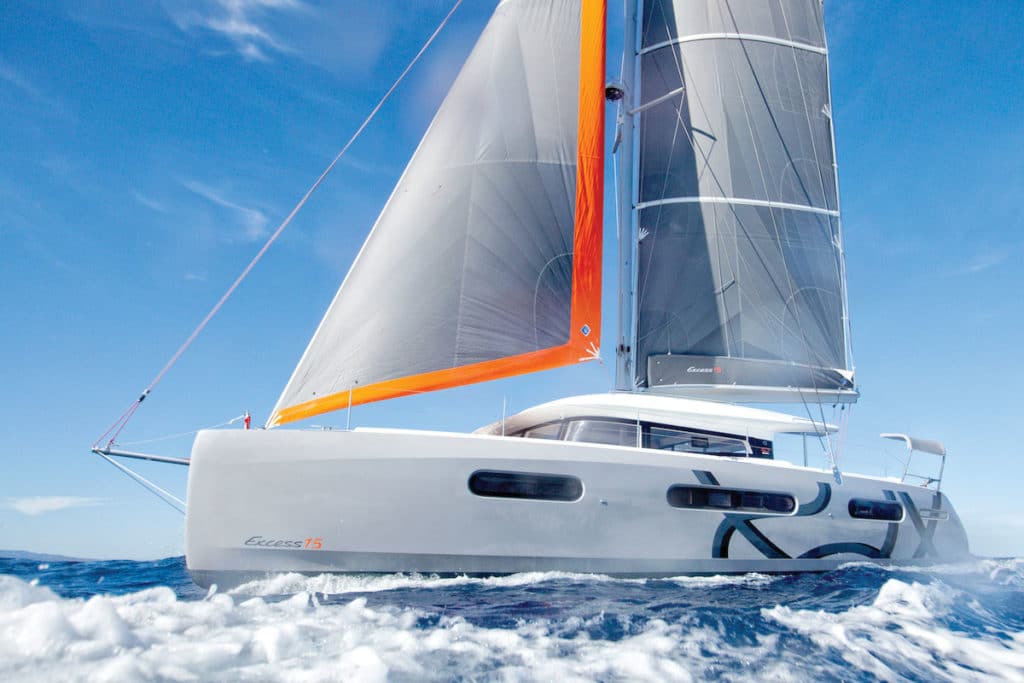
Big Sister Also Rocks
We’ve already expressed our deep affection for the Excess 11, which we named 2021′s Overall Boat of the Year. But the 11′s big sister, the Excess 15, is also a rocking sailboat that we very much enjoyed sailing. It was also easily worth a prize, and likely would’ve garnered one in an expanded field with a dedicated class of catamarans.
As with the 11, the 15 refers to its length in meters, which translates to 48 feet, 6 inches. So, she’s a big, rangy cat!
Murphy felt one its strongest optional features was right overhead: “In the hardtop Bimini that comes aft over that social space in the cockpit, there’s an optional sunroof built right into it that slides open or closed. This is another one of those kind of design problems we’ve seen on many of the boats that we sail. It’s really lovely to be able to open up the space when you’re under sail and want to see the sunshine or the stars—or when you want clear visibility of the sail plan up through the middle of the boat—and close it against sun or rain. It’s a wonderful feature, and I would recommend that anybody interested in these boats take that option. It’s a very strong one.”
For our test sail on the 15, we powered past a Fort Lauderdale drawbridge and into the cerulean Atlantic (we’d tested the 11 on Chesapeake Bay). It was a revelation. Murphy said: “It was really nice to be able to sail this boat out in waves and, you know, really sail it the way that it’s meant to be sailed. Once we had the sails dialed in and set up, you could really see how easy it would be to just keep going and roll away the miles on this one.”
Pillsbury agreed: “There’s a big, square-top mainsail, but it’s very easy to handle. And I loved the traveler setup on this boat. There’s lots of horsepower, but it’s also simple to control. The self-tacking jib was handy if you’re shorthanded or in close quarters, but rolling out the Code Zero was spectacular. You’re right there feeling the wind, hearing the water. You really are sailing.”
Which, we discovered with each Excess, was the entire point of the exercise.
Southerly 480
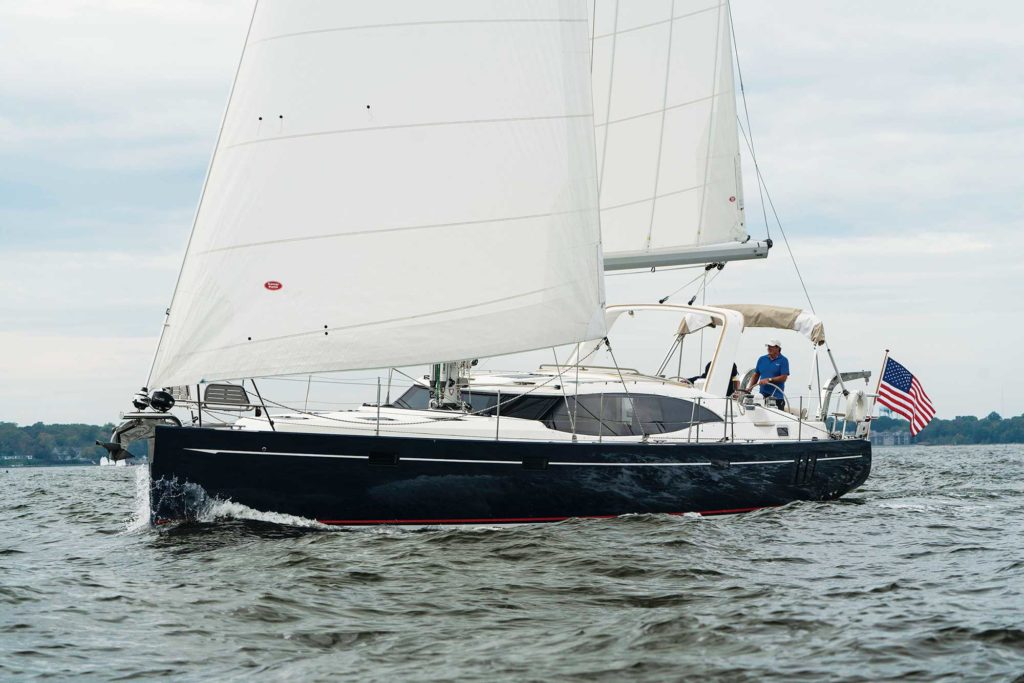
The Swing’s the Thing
If we have but one regret from our weeks of testing yachts for 2021, it has to be with the Southerly 480, built to exceedingly high standards by the craftsmen at Discovery Yachts in Southampton, England. Simply put, we didn’t get to sail this immaculate, clever yacht in the staunch conditions it was intended for. Even so, it was an impressive machine.
Murphy described its signature feature: “With any sailboat, there are some classic design challenges, or tensions, that every single vessel has to solve in one way or the other. One of them is having enough lateral resistance and ballast under the waterline to sail well in the ocean, but not be so deep-drafted that you can’t get into places. This Southerly solves that problem with its variable-swing keel; it’s not a centerboard, it’s a keel—the difference being that it’s a true foil section. So, when the keel is down, you’ve got the hydrodynamic advantages of a foil.
“The whole keel structure is a single unit called either a grounding plate or an armor breastplate,” he continued. “And you can totally dial in the precise amount of draft that you want, depending on whether you’re sailing or trying to enter a shallow harbor. It’s very well-executed, and very effective, in whichever mode you’re in. You can go from a draft of 3 feet, 3 inches with the keel up, to 10 feet, 3 inches when it’s down and out in the ocean. Which means you can go to many, many places in Florida, the Chesapeake and the Bahamas.”
Twin rudders, twin spinnaker poles for setting or poling out one or two jibs, a raised saloon, a very interesting main layout down below on multiple levels for the galley, the nav station, the cabin—we found much to like on the Southerly 480. But it all comes back to that handy, adaptable swing keel, which we unanimously agreed is the real deal.








